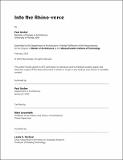| dc.contributor.advisor | Jarzombek, Mark | |
| dc.contributor.author | Gruber, Paul | |
| dc.date.accessioned | 2023-03-31T14:28:51Z | |
| dc.date.available | 2023-03-31T14:28:51Z | |
| dc.date.issued | 2023-02 | |
| dc.date.submitted | 2023-02-28T18:51:58.610Z | |
| dc.identifier.uri | https://hdl.handle.net/1721.1/150058 | |
| dc.description.abstract | Architects and designers are fully reliant on digital tools to complete their work. The need to constantly produce creative work has reached exhausting speeds. These programs are exponentially expanding and consuming each other, creating even more complex relationships. Architects are thrown into this technological jumble, expected to keep up with the rapidly evolving modes of production and it is challenging to access and utilize this seemingly infinite digital landscape.
Rhinoceros 3D, a popular architectural modeling software, is a force in the digital design market. Over time, its parent company developed a platform that houses a large group of animal-named plug-ins to expand the capabilities of the Rhino Universe. Every day, new plug-ins are added, downloaded and modified for Rhino users and it is overwhelming to keep up with the changes and additions. The zoological theme allows for a playfulness in architectural design and provides a language to expand the digital scope of the architect. This thesis examines and embraces the absurdist digital landscape to make sense of the relationship between architects and parametric design tools, while also introducing newly imagined animals to control even more aspects of the architectural process.
The project envisions a not-so-distant future where the role of the architect is collapsed to choosing the right combinations of animals to produce a desired, prescribed output. While the abilities of the architect expand through the usage of these tools, there is immense knowledge that collapsed within a Grasshopper component that the architect no longer needs to possess. This thesis views the digital ecosystem as more than just a branding mechanism, but as a useful tool in understanding the possibilities and limitations of digital design thinking in the sometimes-dreary, isolating, and confusing technological environment architects and designers inhabit daily. | |
| dc.publisher | Massachusetts Institute of Technology | |
| dc.rights | In Copyright - Educational Use Permitted | |
| dc.rights | Copyright retained by author(s) | |
| dc.rights.uri | https://rightsstatements.org/page/InC-EDU/1.0/ | |
| dc.title | Into the Rhino-verse | |
| dc.type | Thesis | |
| dc.description.degree | M.Arch. | |
| dc.contributor.department | Massachusetts Institute of Technology. Department of Architecture | |
| dc.identifier.orcid | https://orcid.org/0000-0003-1211-186X | |
| mit.thesis.degree | Master | |
| thesis.degree.name | Master of Architecture | |
